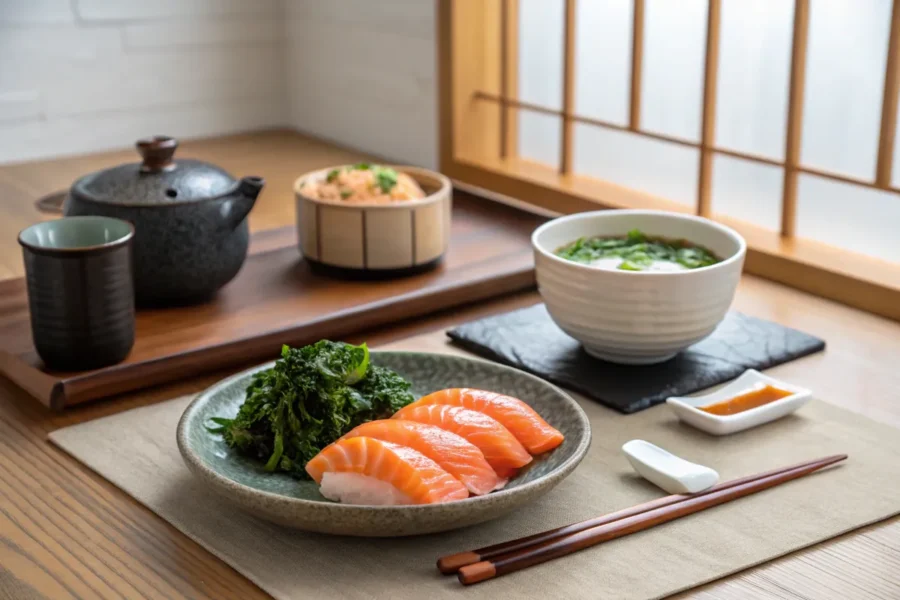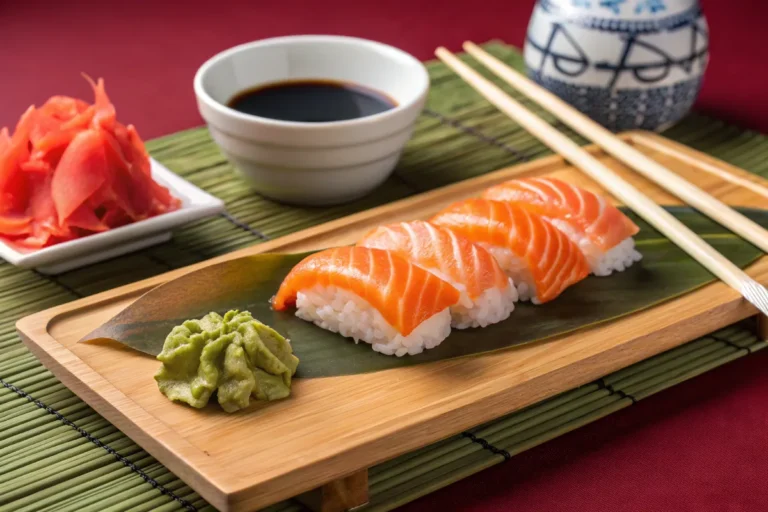Salmon nigiri is a delectable Japanese dish that combines simplicity with elegance. This iconic sushi item features slices of fresh salmon placed atop perfectly seasoned rice, bound by tradition and crafted with precision. In this guide, we’ll explore the rich history, meticulous preparation techniques, and nutritional benefits of salmon nigiri, while also diving into tips for creating this culinary masterpiece at home. Whether you’re a sushi connoisseur or new to Japanese cuisine, there’s something here for everyone.
Table of Contents
Introduction to Salmon Nigiri
What is Salmon Nigiri?
Salmon nigiri is a popular sushi dish that captures the essence of Japanese culinary art. “Nigiri” translates to “hand-pressed,” referencing the oblong-shaped rice bed that cradles a delicate slice of sushi-grade salmon. The combination of vinegared rice and fresh fish is simple yet incredibly flavorful, making it a favorite worldwide.
A Brief History of Nigiri in Japanese Cuisine
Nigiri sushi has its roots in the bustling streets of Edo-period Japan (1603–1868). Originally, it was a form of fast food, with fish preserved in vinegar served atop compact rice portions for easy handling. Salmon nigiri gained prominence later, as trade with Norway introduced high-quality salmon to Japanese markets in the 1980s. Today, it’s a global phenomenon, gracing sushi bars from Tokyo to New York.
Why Salmon is a Popular Choice for Nigiri
Among the variety of fish used in nigiri, salmon stands out for its rich flavor, vibrant orange hue, and health benefits. Packed with omega-3 fatty acids and protein, it offers a nutritious option without compromising on taste. Its buttery texture complements the seasoned rice, creating a balanced and indulgent experience. Plus, salmon’s versatility means it pairs beautifully with traditional condiments like wasabi, soy sauce, and pickled ginger.
In the next section, we’ll delve into the essential ingredients and preparation techniques that bring salmon nigiri to life. From selecting the freshest fish to crafting perfect sushi rice, you’ll learn the secrets to mastering this dish.
Ingredients and Preparation of Salmon Nigiri
Essential Ingredients for Salmon Nigiri
To create authentic salmon nigiri, start with high-quality ingredients. The most critical is sushi-grade salmon, which ensures freshness and safety for raw consumption. You’ll also need sushi rice (Calrose or short-grain rice works best), rice vinegar, sugar, and a pinch of salt for seasoning. Don’t forget classic accompaniments like wasabi, soy sauce, and pickled ginger to enhance the flavors.
How to Choose the Best Sushi-Grade Salmon
When selecting salmon, look for fish labeled as “sushi-grade” or “sashimi-grade.” These terms indicate the salmon has been flash-frozen to kill parasites, making it safe for raw preparation. A fresh piece of salmon should be vibrant orange with no discoloration, smell clean like the ocean, and have a firm texture.
Preparing Perfect Sushi Rice
The rice in salmon nigiri is as important as the fish. Start by rinsing the rice until the water runs clear to remove excess starch. Then cook it according to the package instructions, adding a mixture of rice vinegar, sugar, and salt while it’s still warm. This step ensures the rice is flavorful and sticky enough to form cohesive rice balls.
The Role of Wasabi, Soy Sauce, and Pickled Ginger
These condiments elevate salmon nigiri from simple to sublime. Wasabi provides a spicy kick, soy sauce adds a salty depth, and pickled ginger acts as a palate cleanser between bites. Use them sparingly to let the salmon’s natural taste shine.
Crafting the Perfect Salmon Nigiri

Step-by-Step Guide to Assembling Nigiri
Creating salmon nigiri at home might seem daunting, but it’s surprisingly straightforward. Begin by slicing the salmon into thin, rectangular pieces about 2-3 inches long. Wet your hands with water to prevent sticking, then shape small portions of seasoned rice into compact, oblong forms.
Knife Skills: Slicing Salmon Like a Pro
The right technique ensures your salmon slices are uniform and delicate. Use a sharp knife to cut against the grain for a tender bite. Hold the knife at a slight angle to produce even pieces with clean edges.
Shaping the Rice: The Ideal Form
Nigiri rice balls should be small enough to eat in one bite but firm enough to hold their shape. Lightly compress the rice in your hands while ensuring it retains a fluffy texture.
Topping and Serving Techniques
To assemble, place a dab of wasabi on one side of the salmon slice before pressing it gently onto the rice. Serve your salmon nigiri immediately for the best flavor and texture. Pair with soy sauce and pickled ginger for an authentic sushi experience.
Health Benefits of Salmon Nigiri
Nutritional Profile of Salmon
One of the reasons salmon nigiri is such a beloved dish is its outstanding nutritional benefits. Salmon is rich in omega-3 fatty acids, which are essential for brain health and reducing inflammation. Each piece also provides high-quality protein, vitamin D, and essential minerals like selenium and potassium. Combined with the carbohydrates in sushi rice, this dish is a well-rounded option for those looking for a satisfying yet light meal.
Omega-3 Fatty Acids and Heart Health
The omega-3s in salmon are known to support heart health by lowering triglycerides and reducing the risk of arrhythmias. Regularly including omega-3-rich foods, like salmon nigiri, in your diet may also improve cholesterol levels and overall cardiovascular function.
Low-Calorie, High-Protein Benefits
For those mindful of their calorie intake, salmon nigiri is an excellent choice. Each piece typically contains under 100 calories while delivering a filling combination of protein and healthy fats. This balance makes it ideal for a quick, nutritious snack or as part of a larger meal.
Cultural and Culinary Significance of Salmon Nigiri
Salmon Nigiri in Japanese Culture
Salmon nigiri holds a special place in Japanese cuisine, symbolizing a fusion of tradition and modern culinary innovation. While traditional nigiri often featured fish like tuna or mackerel, salmon became popular in Japan during the 1980s, thanks to Norwegian exports. Today, it represents the evolution of sushi culture, blending global influences with classic Japanese techniques.
How Nigiri Differs from Sashimi and Sushi Rolls
Many people confuse nigiri with sashimi or sushi rolls, but they are distinct. Nigiri features hand-formed rice topped with fish, while sashimi is simply thinly sliced raw fish served without rice. Sushi rolls, on the other hand, are wrapped in seaweed and often include a mix of ingredients. This unique combination of simplicity and flavor makes salmon nigiri a standout.
Modern Twists and Fusion Variations
While traditional salmon nigiri is a purist’s delight, chefs worldwide have introduced creative variations. From seared salmon with a blowtorch to adding garnishes like truffle oil or yuzu zest, these innovations keep the dish fresh and exciting for contemporary palates.
Tips for Serving and Enjoying Salmon Nigiri
Pairing Salmon Nigiri with Sake and Other Drinks
Pairing salmon nigiri with the right drink can elevate your dining experience. Light and dry sake complements the dish beautifully, enhancing the subtle flavors of the salmon. If you prefer non-alcoholic options, green tea or sparkling water with lemon are excellent choices.
How to Eat Nigiri the Traditional Way
When eating salmon nigiri, it’s customary to dip the fish, not the rice, into soy sauce. This technique prevents the rice from absorbing too much soy sauce and ensures you taste the fish’s full flavor. Using chopsticks is polite, but it’s also acceptable to eat nigiri with your hands.
Popular Side Dishes to Accompany Nigiri
To create a complete meal, serve salmon nigiri with light sides like miso soup, edamame, or seaweed salad. These dishes complement the delicate flavors of the sushi without overpowering them, providing a well-rounded dining experience.
For a broader range of Japanese-inspired recipes, explore creative ideas that pair well with sushi. Check out similar recipes for inspiration!

FAQs
How Many Calories Are in One Piece of Salmon Nigiri?
Each piece of salmon nigiri typically contains between 60 and 90 calories, depending on the size and ingredients. This calorie count includes the sushi rice and the salmon topping, making it a low-calorie yet satisfying option. For those watching their intake, salmon nigiri offers a guilt-free way to enjoy sushi.
What is Nigiri vs. Sashimi?
Nigiri and sashimi are both staples of Japanese cuisine, but they have key differences. Nigiri is made with a hand-pressed ball of seasoned rice topped with raw fish, like salmon. Sashimi, on the other hand, is simply raw fish served on its own. While sashimi highlights the pure flavor of the fish, nigiri combines textures and flavors for a more layered experience.
What Makes Sushi-Grade Fish Different?
Sushi-grade fish is carefully selected and processed to ensure safety for raw consumption. It’s flash-frozen to kill parasites, maintaining its texture and flavor. Using sushi-grade salmon for salmon nigiri is essential for both taste and safety, so always verify its quality when purchasing.
Can Salmon Nigiri Be Made at Home Safely?
Yes, with the right precautions, salmon nigiri can be made safely at home. Use sushi-grade salmon, handle it with clean utensils, and serve it fresh. Properly prepared sushi rice and careful storage of ingredients will ensure a safe and delicious result.
Conclusion:
Why Salmon Nigiri is Loved Worldwide
Salmon nigiri holds a special place in the hearts of sushi lovers everywhere. Its simplicity, elegance, and balance of flavors make it a standout dish. The tender, buttery texture of salmon paired with the slightly tangy sushi rice creates a harmony that’s hard to beat. Whether enjoyed at a high-end sushi bar or made at home, salmon nigiri continues to delight taste buds around the globe.
Encouraging Experimentation and Appreciation for Japanese Cuisine
Part of what makes salmon nigiri so appealing is its versatility. Traditional recipes are timeless, but adding unique twists, such as a sprinkle of citrus zest or a drizzle of spicy mayo, can elevate the dish to new heights. Moreover, learning to prepare this sushi favorite fosters a deeper appreciation for the artistry and culture of Japanese cuisine.
The journey of mastering salmon nigiri is as rewarding as the dish itself. So, don’t hesitate to roll up your sleeves, experiment with flavors, and create something uniquely yours.

